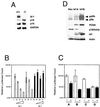Id1 regulation of cellular senescence through transcriptional repression of p16/Ink4a
- PMID: 11427735
- PMCID: PMC35424
- DOI: 10.1073/pnas.141235398
Id1 regulation of cellular senescence through transcriptional repression of p16/Ink4a
Abstract
The Id family of helix-loop-helix (HLH) transcriptional regulatory proteins does not possess a basic DNA-binding domain and functions as a negative regulator of basic HLH transcription factors. Id proteins coordinate cell growth and differentiation pathways within mammalian cells and have been shown to regulate G(1)-S cell-cycle transitions. Although much recent data has implicated Id1 in playing a critical role in modulating cellular senescence, no direct genetic evidence has been reported to substantiate such work. Here we show that Id1-null primary mouse embryo fibroblasts undergo premature senescence despite normal growth profiles at early passage. These cells possess increased expression of the tumor-suppressor protein p16/Ink4a but not p19/ARF, and have decreased cyclin-dependent kinase (cdk) 2 and cdk4 kinase activity. We also show that Id1 is able to directly inhibit p16/Ink4a but not p19/ARF promoter activity via its HLH domain, and that Id1 inhibits transcriptional activation at E-boxes within the p16/Ink4a promoter. Our data provide, to our knowledge, the first genetic evidence for a role for Id1 as an inhibitor of cellular senescence and suggest that Id1 functions to delay cellular senescence through repression of p16/Ink4a. Because epigenetic and genetic abrogation of p16/Ink4a function has been implicated in the evolution of several human malignancies, we propose that transcriptional regulation of p16/Ink4a may also provide a mechanism for the dysregulation of normal cellular growth controls during the evolution of human malignancies.
Figures




References
Publication types
MeSH terms
Substances
Grants and funding
LinkOut - more resources
Full Text Sources
Other Literature Sources

